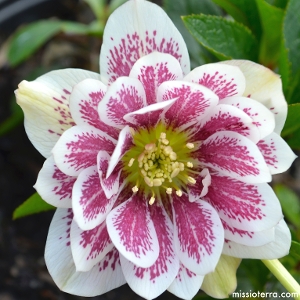
What's the Big Deal About Hellebores? |
Apr 15, 2013 |
 Hellebores are undoubtedly the number one perennial in popularity in the US. But even now, most people have never heard of them, and of those that have fewer are aware of the spectacular colors and forms that are now being offered. Why is that? Well for one thing, the recent explosion of Hellebore cultivars is just that--recent. And in addition, their versatility and longevity in the garden make them all the more valuable.
Hellebores are undoubtedly the number one perennial in popularity in the US. But even now, most people have never heard of them, and of those that have fewer are aware of the spectacular colors and forms that are now being offered. Why is that? Well for one thing, the recent explosion of Hellebore cultivars is just that--recent. And in addition, their versatility and longevity in the garden make them all the more valuable.
You may be surprised to see the colors we are offering. Many of them are just released in the past year or two. Prior to this the colors available were mostly green or white flowered. The visual appeal is now so much greater, we believe hellebores will continue to gain in popularity and exposure. But what is the big deal? Certainly, there are numerous other groups of perennials that are just as showy if not more. Let me tell why.
First, here's a brief history of the hybrid hellebore. The hellebores we offer are actually the children of hundreds of crosses spanning nearly 20 different wild hellebore species. So to call them Helleborus orientalis would be incorrect (even though this is the common misunderstanding). Actually, what we offer is Helleborus x hybridus. That's a big word for hybrid hellebore. To get all the different colors now available, the parentage has been blurred. But no matter, the hybrids have the same qualities that make their less attractive parents so popular.
Second, hellebores grow through the winter and even begin blooming in the winter! When everything else in your garden has gone to sleep, hellebores come to life. Depending upon your conditions, they will begin blooming outside as early as December--sometimes a bit later. So when everything else has hunkered down for the winter, hellebores thrive.
Third, hellebores can be used in a wide range of locations in your garden, from shade (I have seen them doing wonderfully in dark forest shade) to full sun. All they really require is lots of humus (planting mix, organic matter, leaf mold, etc.) incorporated into the soil. As well, they require consistent moisture (although they can endure short periods of drought once established).
Fourth, they are grazing resistant. I do not say grazing proof as I have seen deer nibble on the most poisonous plants known. All parts of hellebores are toxic, so they are considered to be deer, mice, gopher, vole, rabbit, etc. resistant. How many flowers have you fed to the varmints? If you've gardened long enough, I'm sure you can think of some flower you were just about to enjoy only to find it eaten from the top or gone entirely underground to a greedy gopher. Well, when you plant hellebores, you won't have to worry about them disappearing over night.
Fifth, hellebores are long lived--very long lived. Many plantings are known to last 100 years or more! That's longer than probably any flower in the garden. Given their longevity, they are also slow growing. Typically, it takes 4 to 5 years to get a hellebore to bloom from seed, but once they get going, they bloom faithfully and heavily each year. One note here, this is why we offer more mature plants. You won't have to wait several years to get a mature hellebore clump in your garden.
Sixth, hellebores make long lasting cut flowers. Since the stems are short many people choose to float them in a water dish. But the stems are long enough to be used in bud vases or the like.
Since hellebores now come in red, pink, black, yellow, apricot, pink, green, and white in both doubles and singles we feel that hellebores will only continue to enjoy great popularity. In fact, it will undoubtedly take many years for production to keep up with demand.

|
RETURN
|


